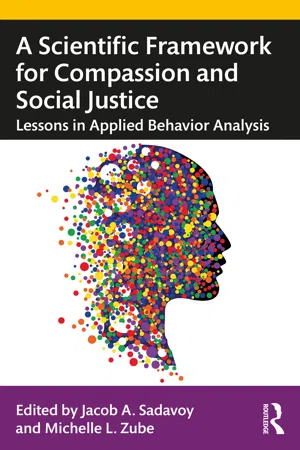
A Scientific Framework for Compassion and Social Justice
Lessons in Applied Behavior Analysis
- 368 pages
- English
- ePUB (mobile friendly)
- Available on iOS & Android
A Scientific Framework for Compassion and Social Justice
Lessons in Applied Behavior Analysis
About This Book
A Scientific Framework for Compassion and Social Justice provides readers with an in-depth understanding of the behavior analytic principles that maintain social justice issues and highlights behavior analytic principles that promote self-awareness and compassion.
Expanding on the goals of the field of applied behavioral analysis (ABA), this collection of essays from subject-matter experts in various fields combines personal experiences, scientific explanations, and effective strategies to promote a better existence; a better world. Chapters investigate the self-imposed barriers that contribute to human suffering and offer scientific explanations as to how the environment can systematically be shaped and generate a sociocultural system that promotes harmony, equality, fulfilment, and love.
The goal of this text is to help the reader focus overwhelming feelings of confusion and upheaval into action and to make a stand for social justice while mobilizing others to take value-based actions. The lifelong benefit of these essays extends beyond ABA practitioners to readers in gender studies, diversity studies, education, public health, and other mental health fields.
Frequently asked questions
Information
1
ACCEPTANCE AND COMMITMENT TRAINING
Acting to Support Compassion-Focused Applied Behavior Analysis
INTRODUCTION
ROOTS OF EMPATHY AND COMPASSION
- I and specific people of different racial/ethnic backgrounds might be the same (e.g., we are all humans, we all want the best for our families, etc.)
- I and people of different religions might be the same (e.g., we both care deeply about our faith, we both care about our right to practice our faith, etc.), and
- I and people of different professions might be the same (e.g., we both care deeply about making a difference, etc.)
ACCEPTANCE AND COMMITMENT TRAINING
Values
Committed Action
Acceptance
Defusion
Present Moment Attention
Table of contents
- Cover
- Half Title
- Title Page
- Copyright Page
- Dedication Page
- Contents
- Acknowledgements
- Introduction Metta-Contingencies
- 1 Acceptance and Commitment Training Acting to Support Compassion-Focused Applied Behavior Analysis
- 2 AGEISM Reconsidering Aging: An Examination of Contextual Factors and the Construct of Old Age
- 3 ABA: An Evolution Rooted in Compassion: How B.F. Skinner Planted the Seeds of Social Justice for Behavior Analysis and How We Have Grown Over the Past 70 Years
- 4 Behavioral Economics In Health and in Sickness: Irrationality of the Decision-Making Process
- 5 Black Lives Matter From Theoretical Conceptualization to Function-Based Real-Life Application
- 6 Blame Not I: A Behavioral Conceptualization of Perpetrator Blame
- 7 Bullying Queen Bees, Wannabees, Bee-havior Analysts: Looking at Bullying through a Behavioral Lens
- 8 Burnout & Self-Care Filling your Vessel: Recognizing Burnout and Choosing Self-Care
- 9 Compassion The Role of Compassion in Social Justice Efforts
- 10 Connectedness Lessons in Cultural Humility, Racial Capitalism, Racial Colorblindness, Implicit Bias, and Colorism
- 11 Corruption An Integrity Violation Examined from a Behavior Analytic Perspective
- 12 Cultural Responsiveness The Development and Implications of Cultural Responsive Practices to Behavior Change Programs
- 13 Culturally Aware Practice Cultural Considerations for Delivering Effective Treatment
- 14 Culture A Cultural Behavioral Systems Science Perspective on the Struggle for Social Justice
- 15 The do Better Movement The Science of Togetherness
- 16 Equitable Education The Role of Behavior Analysts in Providing Equitable Services for Clients in Public Schools
- 17 Feminism We Can Shatter Glass: An Optimistic Reminder to Behavior-Analytic Feminists
- 18 Gendered Language Moving toward a Compassionate Gender Expansive Society
- 19 Global Impact Standing for Science Takes a Village – An International One
- 20 Higher Education Evidence-Based Teaching in Culturally Responsive Higher Education
- 21 Humanity of ABA ABA as a Humane Approach
- 22 Inclusivity “We’ve Tried Nothing and We’re All out of Ideas!”: Disruptive Behavior and Faith-based Congregations
- 23 Income Inequality Understanding the Needs of Economically Disadvantaged Children and Families
- 24 Indigenous Rights Finding the Trail: Indigenous Considerations for Decolonizing Research and Clinical Work
- 25 Islamophobia Behavior Analysis and Islamophobia: A Behaviorist Point of View
- 26 Criminal Justice The Implications of Dissemination of Applied Behavior Analysis in the Criminal Justice System
- 27 LGBTQ2IA Supporting Ontogenic and Cultural Compassion Building for the LGBTQ2IA Community
- 28 Microaggressions Addressing Microaggressions in the Workplace Using Acceptance and Commitment Therapy
- 29 Mindfulness Skills and Lessons Learned during the 2020 Pandemic: A Behavior Analytic View of Honing Mindfulness, Awareness, and Kindness
- 30 Organizational Behavior Management Promoting a Compassionate Culture within an Organization
- 31 Nepantla Finding Spirit: The Pedagogy of Nepantla
- 32 Neurodiversity & Ableism From Accountant to Advocate: Ableism and Neurodiversity in the Workplace
- 33 Perspective Taking A Relational Frame Approach to Understanding Perspective-Taking in Compassion and Social Justice
- 34 Prejudice and Oppression Addressing Societal Issues of Prejudice and Oppression: How Can Behavior Analysis Help?
- 35 Privilege Read, Reflect, Resist: Deconstructing Privilege
- 36 Racism Applying Behavior Analysis to Dismantle Racism: From Ideas to Action
- 37 Rural Access Rural Access to Ethical and Appropriate Behavior Analytic Treatment in Schools
- 38 Sexual Harassment Sexual Harassment in the Modern Era
- 39 Social Categorization & Stereotypes Stop Judging a Person by Their Cover: How Stereotypes Limit Our Connection with Others
- 40 Social Justice An Overdue and Urgent Topic for Behavior Analysis
- 41 Social Media A Global Social Tool or Dilemma?
- 42 Stigma Stigma through a Behavioral Lens: A Kenyan Perspective
- 43 Stimulus Equivalence A Derived Relational Account of Cultural Biases
- 44 Urban Planning Urban Planning through a Behavior Analytic Lens
- 45 Wellness Wellness and the Use of Acceptance Commitment Training in the Workplace
- 46 White Saviorism Lessons Learned and Continued Reflections
- Conclusion Designing Organizations with Love: An ACT Prosocial Framework for Social Justice, Diversity, and Inclusion
- Final Thoughts
- Index